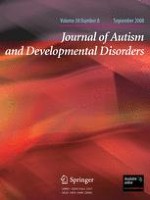01-09-2008 | Original Paper
Language Abilities of Children with Asperger Syndrome
Gepubliceerd in: Journal of Autism and Developmental Disorders | Uitgave 8/2008
Log in om toegang te krijgenAbstract
Current diagnostic taxonomies (ICD-10, DSM-IV) emphasize normal acquisition of language in Asperger syndrome (AS). Although many linguistic sub-skills may be fairly normal in AS there are also contradictory findings. There are only few studies examining language skills of children with AS in detail. The aim of this study was to study language performance in children with AS and their age, sex and IQ matched controls. Children with AS had significantly lower scores in the subtest of Comprehension of Instructions. Results showed that although many linguistic skills may develop normally, comprehension of language may be affected in children with AS. The results suggest that receptive language processes should be studied in detail in children with AS.
